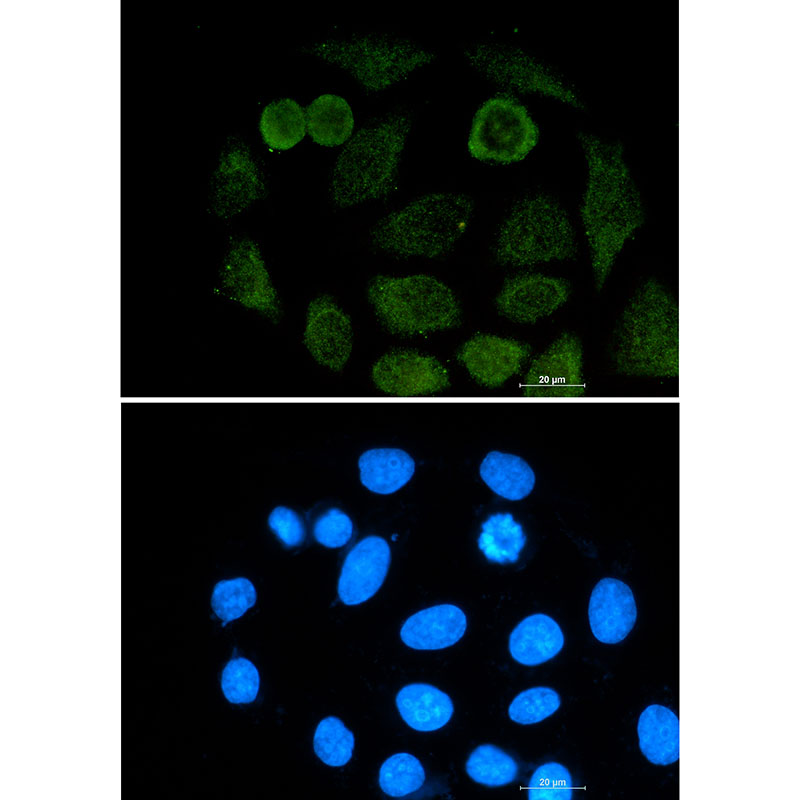

| WB | 咨询技术 | Human,Mouse,Rat |
| IF | 1/20 | Human,Mouse,Rat |
| IHC | 咨询技术 | Human,Mouse,Rat |
| ICC | 1/50-1/200 | Human,Mouse,Rat |
| FCM | 咨询技术 | Human,Mouse,Rat |
| Elisa | 咨询技术 | Human,Mouse,Rat |
| Aliases | ATF2; CREB2; CREBP1; Cyclic AMP-dependent transcription factor ATF-2; cAMP-dependent transcription factor ATF-2; Activating transcription factor 2; Cyclic AMP-responsive element-binding protein 2; CREB-2; cAMP-responsive element-binding pro |
| Entrez GeneID | 1386 |
| WB Predicted band size | Calculated MW: 55 kDa; Observed MW: 70 kDa |
| Host/Isotype | Rabbit IgG |
| Antibody Type | Primary antibody |
| Storage | Store at 4°C short term. Aliquot and store at -20°C long term. Avoid freeze/thaw cycles. |
| Species Reactivity | Human |
| Immunogen | A synthetic peptide of human ATF2 |
| Formulation | Purified antibody in TBS with 0.05% sodium azide,0.05%BSA and 50% glycerol. |
+ +
以下是关于ATF2抗体的3篇代表性文献(基于公开研究总结,具体信息建议通过学术数据库核实):
1. **文献名称**:*"ATF2 confers resistance to ERK inhibitors in melanoma by dual regulation of pro-apoptotic genes"*
**作者**:Bhoumik A, et al.
**摘要**:本研究利用ATF2抗体分析黑色素瘤中ATF2的亚细胞定位及表达水平,发现ATF2通过调控促凋亡基因(如NOXA)增强肿瘤对ERK抑制剂的耐药性,提示其作为治疗靶点的潜力。
2. **文献名称**:*"Activating Transcription Factor 2 (ATF2) phosphorylation regulates its nuclear localization and pro-tumorigenic function"*
**作者**:Lau E, et al.
**摘要**:通过免疫沉淀(ATF2抗体)和质谱分析,揭示了ATF2的磷酸化修饰(如p38/MAPK通路)对其核转位和促肿瘤活性的调控机制,为靶向ATF2的癌症治疗提供依据。
3. **文献名称**:*"ATF2 interacts with β-catenin to regulate Wnt signaling and mammary tumorigenesis"*
**作者**:Kardassis D, et al.
**摘要**:研究利用ATF2抗体进行共免疫沉淀实验,发现ATF2与β-catenin直接互作,协同激活Wnt信号通路,促进乳腺癌发生,提示联合靶向策略的可能性。
4. **文献名称**:*"ATF2 mediates oxidative stress responses and coordinates DNA damage signaling"*
**作者**:Mashima T, et al.
**摘要**:通过Western blot(ATF2抗体)和基因敲除实验,证明ATF2在氧化应激和DNA损伤应答中起核心作用,调控下游修复基因表达,影响细胞存活与凋亡平衡。
**注意**:以上文献信息为示例性质,实际引用时请通过PubMed或Google Scholar核对准确标题、作者及摘要内容。
Activating Transcription Factor 2 (ATF2) antibodies are essential tools for studying the role of ATF2. a member of the leucine zipper family of DNA-binding proteins. ATF2 functions as a transcription factor that regulates gene expression by binding to cyclic AMP-responsive element (CRE) promoter sequences. It is activated through phosphorylation by stress-activated kinases, such as JNK and p38 MAPK, in response to cellular stressors, cytokines, or DNA damage. ATF2 is involved in diverse processes, including apoptosis, cell proliferation, DNA repair, and immune responses. Dysregulation of ATF2 has been implicated in cancer, neurodegeneration, and inflammatory diseases.
ATF2 antibodies are widely used in techniques like Western blotting, immunoprecipitation, chromatin immunoprecipitation (ChIP), and immunofluorescence to detect ATF2 expression, localization, and post-translational modifications (e.g., phosphorylation at Thr69/71). These antibodies often target specific epitopes within the N-terminal transactivation domain or C-terminal DNA-binding domain. Researchers validate ATF2 antibodies using knockout cell lines or siRNA-mediated knockdown to ensure specificity, as cross-reactivity with related transcription factors (e.g., ATF7 or CREB) can occur. Commercially available clones, such as L20 or C-19. are commonly used across human, mouse, and rat models. Studies employing ATF2 antibodies have contributed to understanding its dual roles in tumor suppression (via pro-apoptotic signaling) and oncogenesis (through cooperation with oncoproteins like Jun), as well as its interactions with viral proteins and chromatin modifiers.
×